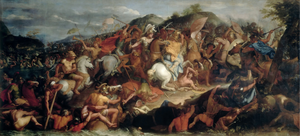Battle of Granicus
| The Battle of Granicus | |||||||||
|---|---|---|---|---|---|---|---|---|---|
| Part of the Wars of Alexander the Great | |||||||||
 The Battle of the Granicus River |
|||||||||
|
|||||||||
| Belligerents | |||||||||
|
League of Corinth |
|
||||||||
| Commanders and leaders | |||||||||
|
Alexander the Great Parmenion Cleitus the Black Hephaestion Calas Hegelochus Ptolemy |
Arsames Rheomithres Niphates † Petines Spithridates † Mithrobarzanes † Arbupales † Mithridates † Pharnaces † Omares † Arsites † Rhoesaces † Memnon |
||||||||
| Strength | |||||||||
| 32,000 infantry (12,000 Macedonians, 7,000 other Greeks, 5,000 mercenaries, 7,000 Odrysians, Triballians and Illyrians, and 1,000 archers) and 5,100 Cavalry (1,800 Macedonians, 1,800 Thessalians, 600 other Greeks, and 900 Thracians and Paeonians) Total: 37,100 |
10,000-20,000 cavalry 10,000-20,000 Greek hoplite mercenaries Total: 20,000-40,000 |
||||||||
| Casualties and losses | |||||||||
| 300 to 400 killed 1,150–1,380 to 3,500–4,200 wounded |
3,000 infantry killed 1,000 cavalry killed 2,000 captured |
||||||||
The Battle of the Granicus River in May 334 BC was the first of three major battles fought between Alexander the Great and the Persian Empire. Fought in Northwestern Asia Minor, near the site of Troy, it was here that Alexander defeated the forces of the Persian satraps of Asia Minor, including a large force of Greek mercenaries led by Memnon of Rhodes.
The battle took place on the road from Abydos to Dascylium (near modern-day Ergili, Turkey), at the crossing of the Granicus River (modern-day Biga Çayı).
After the death of Phillip of Macedon, many of his newly conquered territories desired to take advantage of the perceived weakness of the new young king. These nations included the Illyrians, Thracians, and other Greek poleis. Alexander had to prove the strength of his rule before leaving for his Persian expedition, and crushed several nascent rebellions within Greece and the northern tribes. After extensive planning in Macedonia, Alexander started to prepare for his next major conquest: the invasion of Asia. Before leaving Macedon, Alexander appointed his father’s experienced general Antipater as regent in his absence, leaving him with 9,000 infantry and 1,500 cavalry to maintain control over Macedonia's holdings in Europe. In the spring of 334 BC, Alexander took 2,600 cavalry and went on a 20-day march from Macedon to Hellespont, to join Parmenion in Asia.
Before Alexander and his army were able to cross at Hellespont, the Persian provincial governors, and others in power at that time in Persia, assembled their forces of 10,000 cavalry and 5,000 infantry to the town of Zelea. Memnon was a high-ranking Greek mercenary that was on the Persian side, and he devised a plan to attack Alexander. Memnon essentially told the Persian army to destroy the food and means of food production in the villages that Alexander would have to pass. This would make it harder for Alexander and his army to survive on their long journey before the battle. The satraps did not trust Memnon because of his nationality, and did not ravage their territories. The Persians had two major objectives; first, they would try to force Alexander toward a position of their choosing before he could continue on inland, and second, the Persians hoped to be able to be in a defensive position that would minimize Alexander's advantage in infantry. The Persians advanced from Zelea to the Granicus River, which would be an obstacle for Alexander and his army. The Persians hoped that his army would not be able to hold formation, which would severely cripple its effectiveness, as maintaining the closely packed and mutually supportive formation typically employed by the Greeks was central to their strategy. The Persians awaited the arrival of the Macedonians with all their cavalry in the front line. Alexander, after crossing at Hellespont, then marched 100 km back to the north to meet the Persians.
...
Wikipedia
